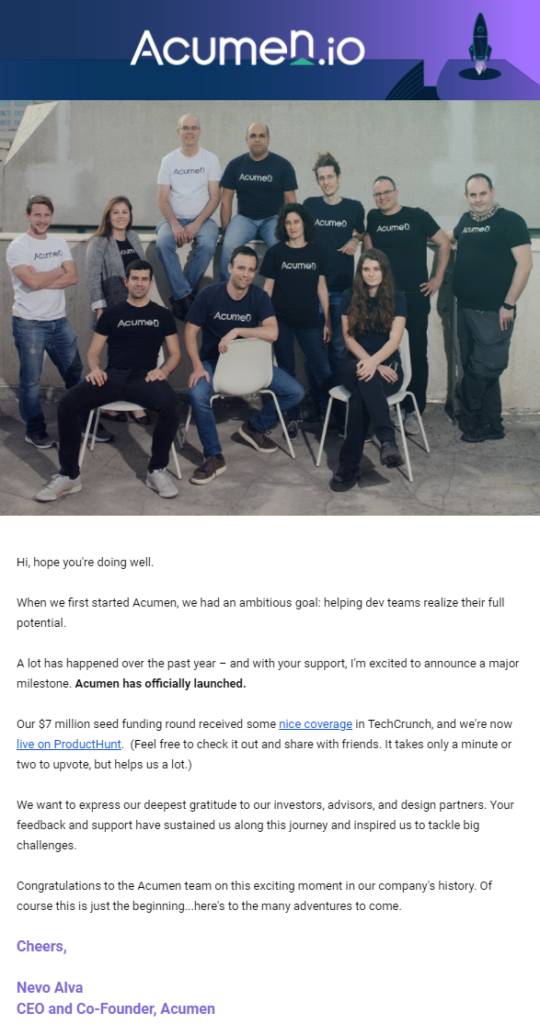Congratulations! After months of quietly working on your product, closing your first customers, and raising that round of funding, you can’t wait to share your startup with the world. In the past few months, you invested in your marketing infrastructure as well, and you now have a new website, with a brand new blog that’s sparkling with fresh content.
In this post, we’ll share our playbook for making your launch campaign as splashy and impactful as possible.

The holy grail of launch marketing: a good TechCrunch article covering your launch.
Goals of a launch campaign
-
Brand awareness across existing and potential clients, investors, and employees. The launch assets — both the ones you produce and the ones you’ll hopefully garner, like press coverage — are major “social proof” that will serve you in the months and years to come. Whenever someone googles your company, they’ll come across your launch press release.
-
Demand generation. A good launch should get you inbound leads, and maybe even deals. It’s hard to predict the volume or quality though — like anything that’s PR-driven, it’s a crapshoot. Therefore, treat any launch-generated leads as a bonus — don’t count on it to make your numbers for the quarter or the year.
-
Fun! The launch follows months of hard work, and is a cause for celebration for your team, investors, and friends & family. It’s a good time to pause, reflect, and thank everyone for their contributions so far — and build excitement for what’s to come.
Launch campaign components
Here are all the pieces you should include in your campaign to make the most out of it.
-
Funding announcement press release (and ensuing press coverage): This is the crown jewel of the campaign, and worth timing and optimizing the campaign around. The reason? It’s not easy for a startup to get press coverage. A funding announcement is (relatively) easier to get coverage for. A good article in a prominent publication (TechCrunch is still the gold standard) means leads, brand exposure, and improved Google rankings. So don’t squander this opportunity: Create a solid press release and secure that coveted coverage. More on how to do that below.
-
Email marketing: Be proactive and share the news with your audience by sending an email announcement to your fledgling email database, which should include your clients, prospects, investors, and partners (see our guide to building your marketing database from 0 to 5000 leads).
Email announcement example:
Announcing Acumen’s launch

-
Social media. Promote the launch the day-of and over the next few weeks on your social media profiles (with an emphasis, as always, on LinkedIn). Share your press release, any press coverage, other related content, and feedback from the industry. Get your entire team involved by liking, commenting on, and re-sharing the posts, to increase exposure.
-
SEO / SEM. You know we’re not proponents of Google advertising, but a launch campaign presents one exception: making sure people find you when they Google your company’s name. For example, if your company is called “milk.ai,” someone reads an article about the launch on TechCrunch, and then Googles “milk ai,” you should be the first result (or at least one of the first). Sometimes this might not happen organically on Google, especially not early on in your company’s life. In that case you’d want to create a small paid Google Search campaign for brand keywords— i.e. keywords that include your company name, founders’ names, and related combinations. Don’t lose valuable visitors because they can’t find you.
-
Website. Feature the funding announcement prominently on your homepage, so that visitors can easily find it. Link to the press release itself or to a blog post featuring it. You can also feature the announcement as a banner that will appear on every page on the site (we’ve had good experiences using Sumo for this). Make sure you have a way to capture email addresses of interested visitors: through a “Contact us” page, a “Demo request” landing page, and/or a mailing list sign-up form.
-
Blog. Publish new content around the announcement on your blog. At a minimum, publish the press release. Additional content can be client case studies and more personal posts from the CEO / founders.
-
Launch event or party with new swag: What’s a better call for celebration? Your launch is the perfect occasion for a “Friends & Family” (and clients and investors) party and new swag. Now’s the time for branded cupcakes! 🧁🧁
-
Other channels. Brainstorm with the team for other activities that may be relevant for your specific product, audience, and timing. Examples: a launch campaign on Product Hunt, working with influencers, or launching during a conference.
Preparing for launch
Launching is a complex, high stakes marketing event. Assign a project owner (usually on the marketing team), who will identify the other stakeholders and put together a project. Here’s an example launch project plan.
Allow at least 4-8 weeks for preparation. The bottleneck here is press outreach: You want to give reporters a heads up of at least a couple of weeks, and sometimes it takes a couple of weeks for them to get back to you. Also, if you’re including clients in the launch (e.g. in a press release quote or a case study), allow ample time for them to create or approve their contributions.
Writing the press release
See our example and template here. Keep it simple, to the point, and include customer names and quotes if possible.
Securing press coverage
Here’s our process:
-
Compile a list of relevant publications and reporters within these publications. It’s not enough to target TechCrunch. You need to find the 1-2 reporters with the highest likelihood to cover you, based on their “beat” (the topics, regions, people they typically cover).
-
Try to find connections to the reporters you’re targeting — your investors are a good bet.
-
Assign priority for each one and reach out by order of priority.
-
Be prepared to email reporters multiple times (we once got a positive response after six emails) over 2-3 weeks. Keep the outreach emails short, simple, and human. Here’s an example template.
-
A reporter replied? Amazing. Swiftly follow up, and stop emailing other reporters (in case it falls through, resume emailing them according to your order of priority). Be prepared to change your launch date according to a reporter’s preference.
Should you work with a PR agency to get coverage? No.
The Bottom Line
Congratulations! The launch campaign is often a startup’s first major marketing milestone. Use it to propel your demand generation efforts, brand awareness, recruiting, and team morale. Make sure you thoughtfully plan and execute the campaign to squeeze all the juice out of this once-in-a-startup’s-lifetime experience.
Further reading
-
Our guide to building your marketing database from 0 to 5000 leads.
-
Looking to buy?? We’re selling!!! – The guide to writing human emails that get replies
-
Why I don’t believe in PR agencies for enterprise B2B startups – and what to do instead
Resources








